The Call of the Ivory-Billed Woodpecker: Its Importance
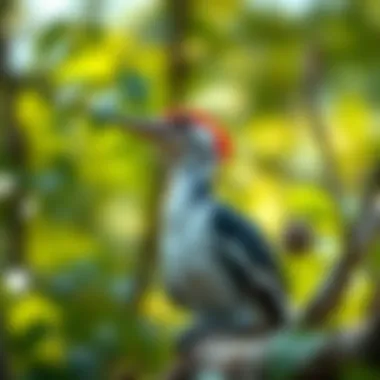
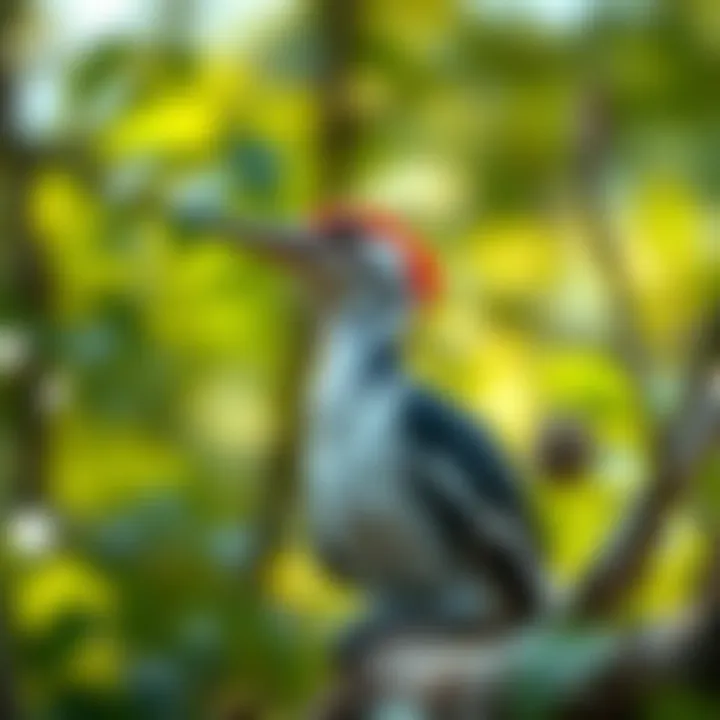
Animal Species Profile
The ivory-billed woodpecker, a feathered giant in the woodpecker family, once graced the forests of the southern United States and parts of Cuba. Its calls echoed through expansive hardwood swamps, but like the whispers of a forgotten legend, it slipped from the grasp of many—its existence challenged by the march of time and human development.
Prologue to the Animal Species
Once a symbol of North American avifauna, the ivory-billed woodpecker embodies resilience and mystery. Known scientifically as Campephilus principalis, this bird is often celebrated not just for its striking appearance but also for its profound ecological role. As a keystone species, it influences the health of forest ecosystems, relying on mature trees that hollow out as nesting sites, serving various insect species alongside them.
Physical Characteristics and Appearance
This woodpecker is remarkable in more ways than one. With a height that can rival that of a crow, adults reach about 18 inches. The plumage is predominantly black, contrasted with a creamy white bill that gives it its name. The males sport a brilliant red crest, whereas the females flaunt a more subtle style without this vibrant adornment. Their large size and distinct characteristics lead to a unique silhouette against the forest backdrop, making them a hard bird to miss, if only they were still abundant in their habitats.
Natural Habitat and Distribution
Historically, the ivory-billed woodpecker thrived in swampy bottomlands, rich old-growth forests consisting of cypress and hardwood trees, primarily thriving in riverine systems. The birds preferred habitats that were lush and undisturbed, ensuring the availability of old trees which were crucial for both nesting and foraging. From Arkansas to Florida, and stretching down into Cuba, these majestic birds’ presence painted the forests they inhabited vibrant with life—until their numbers dwindled alarmingly.
Behavior and Social Interactions
Ivory-billed woodpeckers are not solitary creatures. They exhibit a variety of social behaviors, often seen in pairs or small family groups. Their communication is rich and varied; they employ drumming, a series of rapid taps on trunks or branches, to assert dominance and attract mates. This vocal interplay reflects a complex social structure among them, relying on not only sound but also on their visual rapport in the dense foliage they call home.
Their feeding habits provide insight into their ecological importance; they forage primarily on wood-boring beetles, often creating large cavities in trees, which were utilized by many organisms after the woodpeckers finished with them. These actions underscore the woodpecker's role as a facilitator of biodiversity in their ecosystems.
"The return or continued persistence of the ivory-billed woodpecker is not just a matter of birdwatching; it's a rallying cry for conservation that resonates deeply through our collective responsibility to nature."
Conservation & Wildlife Efforts
Overview of Conservation Status
The ivory-billed woodpecker was declared extinct by the early 1940s due to habitat destruction and hunting pressures. Fascination with reported sightings persisted, fueled by a faint hope that the bird had not entirely vanished. Today, it remains classified as critically endangered, with a shadow of hope buoyed by alleged sightings and ongoing research efforts.
Threats to the Species
Several critical threats pose a formidable challenge to the survival of this magnificent creature. The extensive deforestation, wetlands drainage, and urbanization have severely reduced their natural habitats. Moreover, the very insects they depend on continue to face pressures from climate change and habitat loss. Rebuilding populations becomes a complicated puzzle due to the delicate balance they inhabit.
Conservation Initiatives and Organizations
In the quest to locate and possibly repopulate the ivory-billed woodpecker, various organizations and initiatives have been mobilized. The U.S. Fish and Wildlife Service and The Nature Conservancy are just a few among efforts aimed at habitat restoration and protection. Collaborative research, engaging local communities in conservation efforts, and increased monitoring are also crucial steps taken to keep the ivory-billed woodpecker's story alive.
Success Stories and Impact
While the journey remains fraught with challenges, whispers of success surge through the murky waters of despair. The collaboration among organizations, researchers, and volunteers emphasizes the importance of habitat restoration in other areas can offer hope. For instance, by preserving key habitats and fostering biodiversity, resurgent populations of less critically endangered species indicate signs that restoration efforts work. The ivory-billed woodpecker remains a critical emblem in the canvas of conservation efforts, reminding people of the consequences of inaction.
Animal Behavior & Psychology
Communication and Language Cues
Communication among ivory-billed woodpeckers is multifaceted. Their drumming patterns convey a range of messages, from territorial claims to courting calls. They have a unique system of vocalizations; variations in wood knocks reach beyond mere sounds, suggesting social integration within groups.
Reproductive Behavior and Parenting
Breeding typically occurs in late spring, where pairs establish nesting sites in large trees. After the female lays eggs, both parents share responsibilities in caring for the young. Such shared parenting practices foster strong family dynamics, further solidifying social ties.
Cognitive Abilities and Problem-Solving Skills
The ivory-billed woodpecker demonstrates cognitive prowess in finding food and creating nesting sites. Their capacity for problem-solving comes to light as they navigate the complexities of their habitat, often involving manipulation of branches and the use of tools for foraging.
Emotional Intelligence and Social Dynamics
Not merely instinctual automatons, these woodpeckers showcase signs of emotional intelligence. Observational evidence suggests they form complex social bonds and exhibit protective behaviors towards their peers, hinting at a rich tapestry of social relationships seldom seen in avian life.
Unique Facts & Trivia
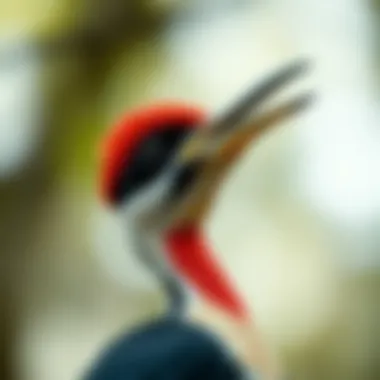
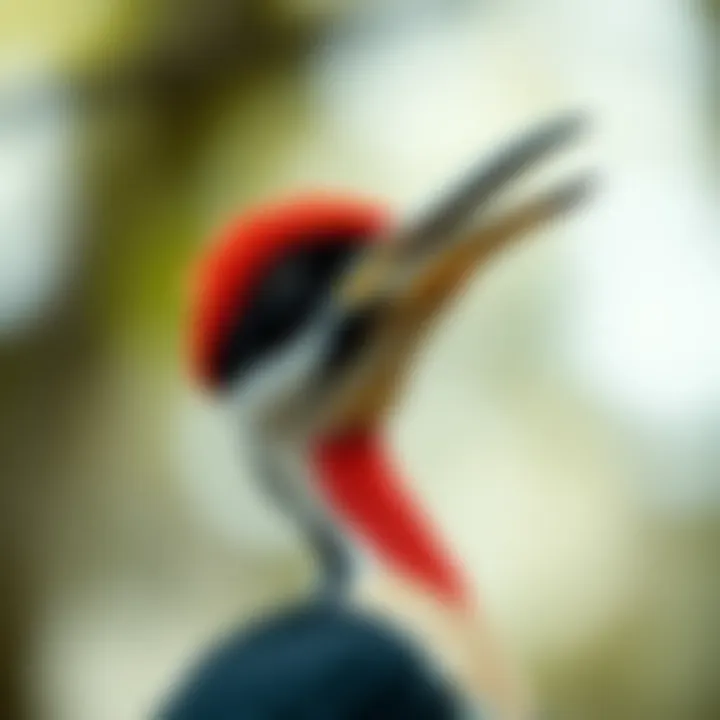
Little-Known Facts About the Animal
- The ivory-billed woodpecker was once considered a symbol of American wilderness.
- It has a striking resemblance to the pileated woodpecker, but is much larger in size.
- Unlike most woodpeckers, it is known to forage primarily on the trunks of trees, rather than on branches.
Surprising Behaviors or Adaptations
This bird has a keen eyesight, crucial for spotting its prey in thick foliage. Its unique adaptations, such as the ability to meticulously strip bark from trees without damaging the tree, reflect evolution at work over thousands of years.
Fun Trivia and Quirky Behaviors
There have been accounts of ivory-billed woodpeckers engaging in mobbing behavior—where they group together to chase off predators or perceived threats, showcasing their capacity for teamwork and strategy in confrontations.
Record-Breaking Feats or Abilities
With the ability to tap at a staggering rate of up to 20 strikes per second, the ivory-billed woodpecker holds an impressive spot in avian performances, surpassing its peers in sheer power and precision.
End
The ivory-billed woodpecker is more than just a bird; it’s a testament to the delicate balance of nature. Each call echoes the richness of ecosystems and underscored the urgency of conservation. Whether this remarkable species finds its footing again in our forests is a question of commitment and understanding. As we strive to protect the biodiversity that shapes our natural world, the call of the ivory-billed woodpecker serves as both a reminder of what we stand to lose and a beacon of hope for what we can recover.
Preamble
The ivory-billed woodpecker is not just another bird tucked away in the annals of ornithology; it’s emblematic of a broader narrative on ecological resilience and the orbits of life we often take for granted. Its call, a blend of reverberating notes echoing through the forests, serves as a soundscape of a time long past, stirring passion among wildlife enthusiasts, scientists, and conservationists alike. This article aims to peel back layers to understand its call, which holds not only biological significance but also serves as a poignant reminder of our role in conserving biodiversity.
Understanding the nuances of the ivory-billed woodpecker’s call offers several layers of insight.
- Ecological Importance: The sound plays a crucial role in the bird's existence, influencing mating rituals and establishing territory.
- Historical Context: Recognizing the call’s relevance through time sheds light on the cultural connections humans have with this majestic creature.
- Conservation Efforts: In an era where so many species teeter on the brink of extinction, understanding the symbolism behind the ivory-billed woodpecker's call could foster greater awareness toward conservation initiatives.
Each section of this article delves into these themes, intertwining aspects of historical background, habitat dynamics, and ongoing efforts to secure the future of the ivory-billed woodpecker. By interspersing scientific research with anecdotal narratives, we will explore how this elusive bird continues to captivate our collective consciousness in an age of environmental uncertainty.
Defining the Call of the Ivory-Billed Woodpecker
Understanding the intricate call of the ivory-billed woodpecker is essential for various reasons. This distinctive sound not only serves as a method of communication among the species but is also a critical part of their identity. Ornithologists have long been captivated by the ivory-billed woodpecker, primarily due to its hauntingly beautiful call that echoes through the forests of the Southern United States. These calls are more than mere sounds; they encapsulate a cultural symbol for wildlife enthusiasts and are a vital focus for conservation efforts.
Characteristics of the Call
The call of the ivory-billed woodpecker is characterized by a series of sharp, resonant sounds that can travel quite a distance through dense canopies. This vocalization plays a significant role in their social dynamics. Here are some key characteristics:
- Volume: The ivory-billed woodpecker's call is particularly loud and distinct, enabling it to be heard even among the cacophony of the forest. Its volume is impressive, likely an adaptation for long-distance communication.
- Pitched Notes: The calls contain a range of frequencies, which can vary depending on the context—be it mating, territory establishment, or alerting others to danger.
- Rhythmic Patterns: The sequence of calls often follows a rhythmic pattern, almost musical in nature. This rhythmic aspect may serve to attract mates or establish dominance.
"The call of the ivory-billed woodpecker is as much a part of the Southern landscape as the cypress swamps themselves. Hearing it is like catching a glimpse of a ghost—rare and hauntingly beautiful."
These characteristics not only define the species but also make it an auditory landmark in the environments it inhabits. Understanding these elements allows researchers to monitor the presence of the bird and its health in the ecosystem. The call is also a significant indicator of the bird’s behavioral patterns, which can link back to its survival and reproduction.
Variations in Vocalizations
Variations in the vocalizations of the ivory-billed woodpecker offer insight into the complexity of their communication. Much like human speech, these birds utilize different calls for different situations. Some noteworthy variations include:
- Alarm Calls: When sensing predators, the birds let out sharp, rapid calls that serve to alert others in the vicinity.
- Mating Calls: During courtship, males produce deeper, more resonant calls to attract potential mates. These calls are often embellished with intricate variations that showcase the individual male's health and genetic fitness.
- Territorial Calls: To establish a territory, individuals may engage in a series of loud, repetitive calls aimed at warning rivals. This form of vocalization can also serve to inform potential mates that an area is claimed.
- Soft Calls: In contrast, softer and more soothing calls might be used during nurturing phases, as they create a calming atmosphere for chicks or during intimate interactions between mated pairs.
These vocal variations are crucial for survival and reproduction; understanding them allows researchers and aficionados alike to appreciate the complexity of the ivory-billed woodpecker's social structure. Recognizing the purpose and meaning behind these sounds provides a deeper appreciation for this near-mythical bird, reminding us all of the delicate interplay between nature and its inhabitants.
Significance of the Call
Understanding the significance of the call of the ivory-billed woodpecker involves delving into several layers of biological and ecological importance. The call serves not only as a means of communication among the species itself but also as a critical signal within its ecosystem. This article will explore how the call resonates well beyond the bird itself, influencing various aspects of avian life and conservation efforts.
Communication Among Species
The ivory-billed woodpecker's call, rich and resonant, functions as a powerful conduit for communication. In the lush canopies of North American forests, its distinctive "kent" call resonates, transcending the barriers of dense foliage. Various studies and anecdotal observations suggest that this call has different meanings depending on its context. It is used for recognizable purposes such as:
- Territorial Marking: The call serves to establish territory, signaling to other birds that an area is occupied.
- Warning Signals: In moments of distress, the call might evolve into a more urgent tone, alerting companions about potential threats.
- Social Bonds: Within groups, individuals may use calls to reinforce social structures and maintain cohesion among members.
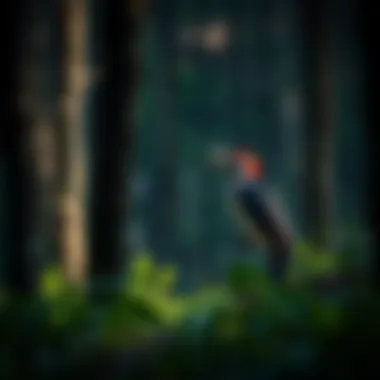
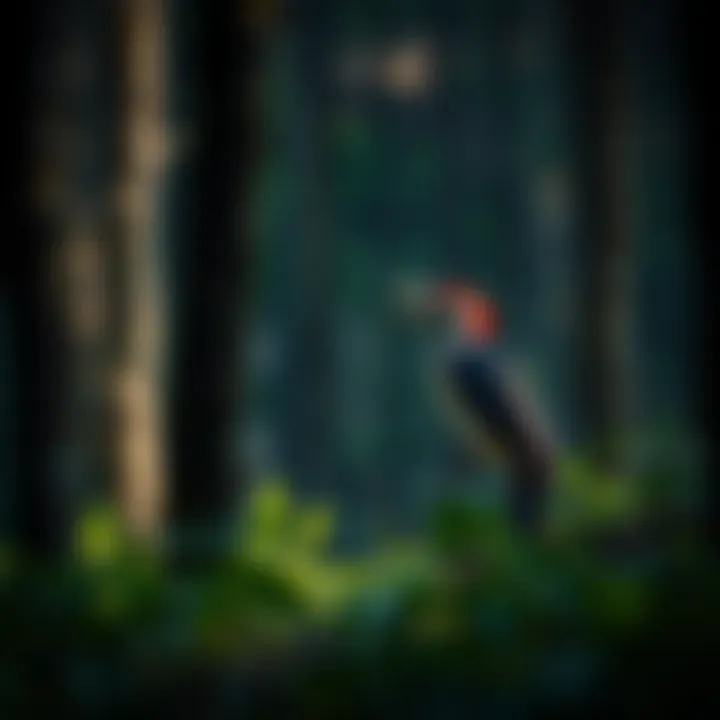
"Bird calls can be as complex as human language. The ivory-billed woodpecker's vocalization is an example of this rich auditory expression, showcasing the interconnectivity of species in a shared habitat."
Such communication facilitates cooperation and interaction among various species in the forest. For example, smaller birds often heed the calls of larger woodpeckers, gaining insight into potential dangers lurking in their vicinity. Moreover, the call of the ivory-billed woodpecker may influence the behaviors of other wildlife, creating a dynamic ecological relationship.
Role in Mating Rituals
The mating calls of the ivory-billed woodpecker are particularly noteworthy, demonstrating the significant role vocalizations play in the reproductive cycle. During the breeding season, males typically engage in heightened vocal activity to attract females. These calls can be characterized by their intensity and frequency, often showcasing:
- Increased Repetition: Males will deliver rapid, repetitive calls to showcase vitality and desirability to potential mates.
- Variations in Tone: Subtle differences in pitch and inflection can communicate health and genetic fitness, key components in mate choice.
The courtship behavior encompasses not just vocalization but also visual displays, creating a multifaceted approach to attraction. As the male woodpecker calls, he may also be seen performing aerial displays or drumming against trees, emphasizing his physical prowess as well.
Through these calls, the ivory-billed woodpecker weaves together a tapestry of interaction and attraction, vital for population sustainability. In this way, the call captures not just a moment of sound, but the very essence of life and reproduction within its world. The harmonic interplay of calls ensures that these birds can find partners, perpetuating their lineage and contributing to the biodiversity of their environment.
The Call Through the Years
The ivory-billed woodpecker's call has echoed through decades, serving as a crucial element of its identity and a symbol of its fate in the wild. Historical and modern accounts of its vocalizations provide a window into understanding not only the species itself but the environment it inhabits. The ways in which the calls have been recorded over time reveal changes in perception, conservation efforts, and the broader ecological landscape. In recognizing these subtleties, one grasps the importance of preserving the call and, by extension, the ivory-billed woodpecker's rightful place in our natural heritage.
Historical Accounts of Observations
Historically, the call of the ivory-billed woodpecker was not just a sound but a conversation; it conveyed information, emotion, and intention within its habitats. Early accounts from naturalists and birdwatchers in the early 20th century describe the call as a series of sharp, distinctive sounds, often likened to the echo of a wooden drum. These rich descriptions not only documented the woodpecker’s presence but also depicted a vibrant, thriving ecosystem.
"The call resonates through the forest like a note from the past, pitching us back to a time when these birds were aplenty, filling our woods with their rhythm."
During this period, the communication among birds facilitated their social structures. Birdwatchers, drawn to these calls, flocked to the southern swamps and wild forests searching for glimpses of the majestic bird. Notably, key figures like John James Audubon documented their experiences, which contributed to early conservation awareness.
While photographs were scarce, ornithologists recorded sounds and sightings to piece together the bird’s behavior and migration patterns. It's fascinating to see how those observations, filled with optimism, helped lay the groundwork for the conservation initiatives that followed as their numbers began to dwindle.
Modern Observations and Interpretations
Fast forward to the present, and the ivory-billed woodpecker still captivates the minds of ornithologists and amateur birdwatchers alike. With the advancement of technology, the methods of observing and interpreting these calls have transformed dramatically. Modern acoustic monitoring has provided deeper insights into the behavior of the ivory-billed woodpecker and even its elusive call.
Researchers now employ sound recorders and sophisticated software to capture and analyze calls that were once only vaguely understood. This technological leap not only helps in distinguishing the ivory-billed woodpecker’s calls from those of similar species but also sheds light on its population dynamics in the field.
As researchers delve into these modern interpretations, they begin to unravel the complex tapestry of the bird's ecological role, communication strategies, and habitat preferences. These efforts demonstrate the ongoing relevance of the call in discussions about biodiversity and conservation strategies. The data gathered enhances our understanding of how sound can significantly influence mating rituals, territory establishment, and social interactions within the species.
In sum, the evolution of the ivory-billed woodpecker's call—from historical shout echoed in swamps to modern-day analytical observations—illustrates the connection between the bird, its surroundings, and the conservation efforts aimed at preserving both.
Conservation Status and Efforts
The conservation status of the ivory-billed woodpecker is a critical element in understanding the larger narrative surrounding this remarkable bird. As it stands, there is a significant institutional commitment to uncovering the truth about its existence, alongside a growing public interest that plays a vital role in these efforts. The potential rediscovery of this iconic bird serves as not just a message of hope, but also a clarion call to preserve our natural ecosystems. To delve deeper, it's essential to break this section down into two main parts: current conservation measures and the successes and challenges faced in these initiatives.
Current Conservation Measures
In recent years, various organizations and researchers have stepped forward to create a structured approach to conserve the ivory-billed woodpecker and its habitat. These conservation measures include a blend of community engagement, habitat restoration, and research initiatives. Some key efforts include:
- Habitat Restoration: Much of the ivory-billed woodpecker's preferred habitat has been severely compromised. Restoration efforts are underway, focusing on re-establishing the ancient forests that once flourished in the southeastern United States. These efforts are aimed not merely at sustaining the woodpecker population but also at restoring entire ecosystems.
- Community Involvement: Local communities have started rallying around the cause. There are programs that encourage folks to participate in monitoring and reporting sightings, which is a crucial step in gathering data on what remains of the population. The idea is to create a grassroots awareness that emphasizes the role each individual can play in preservation.
- Research Programs: Numerous universities and independent researchers have focused their studies on understanding the ecological role of the ivory-billed woodpecker. This work often involves creating a framework to track biodiversity and monitor long-term ecological changes, which includes vocalization patterns, nesting sites, and feeding behaviors.
"The persistence of hope in searching for the ivory-billed woodpecker reflects our broader responsibility to care for biodiversity across the globe."
— Conservation Biologist
Through these combined efforts, organizations strive to maintain not only the mystique of the ivory-billed woodpecker but also to foster a renewed sense of ecological responsibility among people.
Successes and Challenges
While there has been remarkable progress, the journey of conserving the ivory-billed woodpecker isn't all smooth sailing. Several successes have been recorded, yet equally significant challenges remain that can and do derail progress.
Successes include:
- Increased Awareness: Thanks to various media coverage and documentaries, people are more aware of the plight of the ivory-billed woodpecker now than ever before.
- Biodiversity Initiatives: The efforts aimed at saving this species often catalyze broader conservation actions that benefit numerous other wildlife species in the area. This synergistic effect adds value to conservation actions.
However, challenges such as:
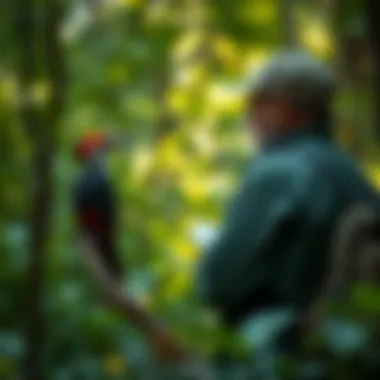
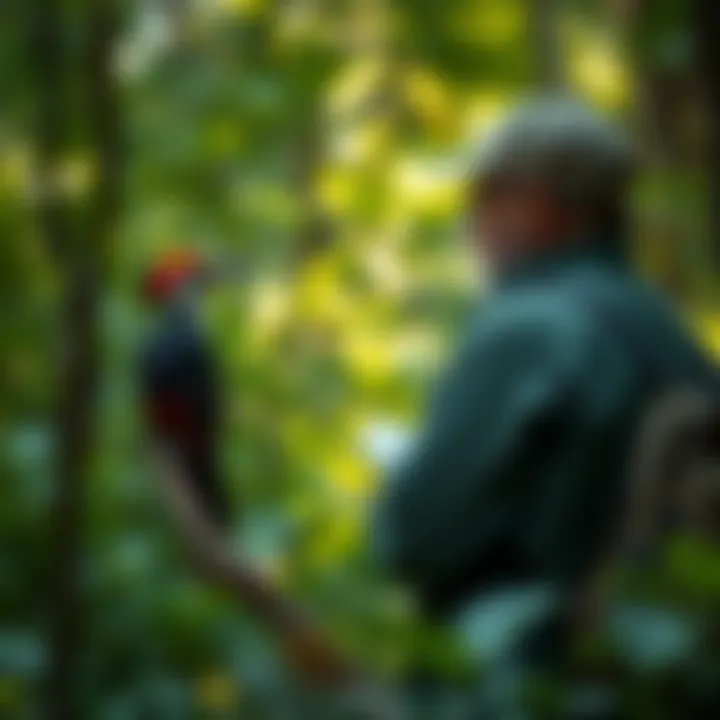
- Funding Limitations: Despite the enthusiasm and interest from local communities and organizations, securing consistent funding for long-term projects poses a significant hurdle.
- Ecological Changes: Climate change and habitat fragmentation continue to threaten the remnants of the habitat that the ivory-billed woodpecker once called home.
All in all, while the pendulum swings between success and challenges, the ongoing conservation journey of the ivory-billed woodpecker illustrates the broader human endeavor to connect with and care for the delicate threads that sustain biodiversity.
Anecdotal Evidence and the Community
The realm of the ivory-billed woodpecker isn't just defined by scientific observations and scholarly articles. The community—comprising both local residents and passionate birdwatchers—plays a pivotal role in the ongoing saga of this species. Anecdotal evidence, while often dismissed in academic circles, actually provides rich layers to understanding not just the bird's calls but also the cultural and ecological narratives surrounding it.
Local Community Involvement
In many regions where the ivory-billed woodpecker was once spotted, communities have rallied around its legacy. These areas tend to have close-knit populations familiar with their forest environments. Residents often recount personal stories, linking their lives to the bird's presence. Many older locals speak of summers filled with the striking call of these woodpeckers and how it shaped their experiences outdoors. Such narratives give insights that go beyond what data can convey. They reflect human perspectives on habitats, emphasizing a deep connection to the land and its wildlife.
- Education of Youth: Local schools have also started programs to teach children about the woodpecker’s significance, fostering a new generation of conservationists. One school in Florida, for instance, runs field trips to nearby wetlands encouraging students to listen for the elusive calls.
- Community Events: Regular community events such as the annual birdwatching festival in Arkansas celebrate local biodiversity and often feature the ivory-billed woodpecker. This festival not only raises awareness but creates a sense of togetherness among participants.
Through these efforts, local voices contribute to a broader narrative, enriching the study of this bird beyond statistics. They transform the ivory-billed woodpecker into more than just a symbol of conservation disaster; it becomes an integral part of the community’s identity.
The Role of Birdwatching Groups
Birdwatching groups have emerged as crucial allies in the quest to understand and conserve the ivory-billed woodpecker. These organizations regularly conduct field studies, often armed with the latest technology, and contribute detailed observations about the calls and behaviors of these birds.
Many amateur ornithologists have spent countless hours in the woods, driven by sheer passion. They share findings on platforms like Reddit or dedicated forums, making their insights accessible to both the scientific community and curious enthusiasts. This blend of amateur enthusiasm and professional scrutiny enriches the collective knowledge surrounding the ivory-billed woodpecker, creating a collaborative environment that can endure. Additionally, much of the most compelling evidence of recent sightings often comes from these community groups, emphasizing their importance as watchdogs for nature.
As they photograph, document, and celebrate bird species, birdwatchers are not merely passive observers. Their engagement often translates into action, from advocating for better protections of natural habitats to joining conservation initiatives aimed at improving the ecosystem's health.
In essence, the amalgamation of local community anecdotes and the rigorous enthusiasm of birdwatching groups culminates in a broad, holistic understanding of the ivory-billed woodpecker’s significance. Together, they champion its legacy, creating a nuanced story that threads through time and nature.
"A bird does not sing because it has an answer. It sings because it has a song." – Chinese Proverb
This excerpt aptly reflects the collective spirit of those invested in the ivory-billed woodpecker saga, proving that the call of this magnificent bird resonates far beyond its physical presence in the forest.
The Future of the Ivory-Billed Woodpecker
The future of the ivory-billed woodpecker is a topic of considerable importance, not just for ornithologists but for anyone who cares about the environment and biodiversity. As a species that has danced on the brink of extinction, the ivory-billed woodpecker embodies the human struggle against habitat loss, climate change, and the persistent threat of species decline. Its call, a haunting echo through the forests, is much more than a simple bird sound; it symbolizes resilience and the ongoing commitment to conservation efforts.
Technological Advances in Research
With the advancement of technology, notably in the fields of audio recording and data analysis, researchers have some promising tools at their disposal for tracking the ivory-billed woodpecker. One significant development has been the use of automated recorders and machine learning algorithms. These technologies can sift through hours of audio footage to identify specific calls and behaviors of the woodpecker.
- Remote Sensing: Satellite imagery can help monitor changes in land use, giving insights into habitat restoration or destruction.
- Drones: Equipped with high-resolution cameras, drones can reach remote habitats and survey areas more efficiently than human researchers on foot.
- Genetic Research: Understanding the genetic make-up of the ivory-billed woodpecker can offer clues about its adaptability and resilience, providing critical information for future conservation plans.
The cumulative effect of these advances offers hope, as researchers can track populations more accurately, assess genetic diversity, and pinpoint effective conservation strategies. Even if no living individuals are found today, these tools could help locate the woodpecker if it still exists in hidden pockets of its former range.
Public Interest and Awareness
Public interest is a key driver in the quest to secure the future of the ivory-billed woodpecker. Awareness campaigns have garnered support from various communities including birdwatchers and conservationists. Local communities often play a crucial role in conservation efforts; they have firsthand knowledge of their ecosystem and can be strong advocates for protecting native species.
- Educational Programs: Organizations like the Audubon Society and local wildlife agencies offer workshops and citizen science initiatives to engage the public.
- Social Media Campaigns: Platforms like Facebook and Reddit provide a pulse on the conversations surrounding wildlife conservation, making it easier for enthusiasts to share sightings or report environmental changes.
- Collaborative Initiatives: Partnerships between governmental and non-governmental organizations can lead to impactful conservation measures, fostering a sense of shared responsibility.
The more people are aware of the ivory-billed woodpecker and its story, the more likely they are to support habitat conservation projects. This heightened awareness can lead to increased funding and volunteer efforts, bolstering initiatives aimed at safeguarding the bird’s historical haunts for future generations.
"Conservation is a cause that has no end. There is no point at which we will say our work is finished." - Rachel Carson
Investing in public interest not only benefits the ivory-billed woodpecker but also raises overall consciousness about ecological preservation, ensuring the survival of countless species that share its habitat. The road ahead is undoubtedly fraught with challenges, yet every step taken today turns the tide toward a future where the call of the ivory-billed woodpecker can once again resonate with the rhythms of nature.
End
The exploration of the ivory-billed woodpecker's call reveals much more than just a series of notes emanating from the depths of swamps and forests. It stands as a potent symbol of conservation and biodiversity. Its elusive nature has transformed it into a beacon of hope, illustrating the vital connection between the species we strive to protect and the ecosystems that support them. As we reflect on the significance of this remarkable bird, it becomes evident that our efforts in conservation should not only focus on saving the species but also the habitat in which it thrives.
The Call as a Symbol of Conservation
The call of the ivory-billed woodpecker does not merely echo through the trees; it resonates deeply within the hearts of those dedicated to preserving natural environments. Each echo serves as a reminder of the fragility of our ecosystems. The history surrounding this bird's fate highlights the consequences of neglecting our responsibilities as stewards of the Earth.
Key Aspects of Its Symbolism:
- Awareness: The call encourages a greater awareness of the plight of many species and challenges communities to think critically about conservation measures.
- Advocacy: It promotes advocacy efforts that aim to ensure sustainable forestry and land use practices, critical for the survival of many species residing in the same habitats.
- Connection: For birdwatchers and nature lovers, it is a tangible connection to the past, an emblem of what could be lost if preservation efforts do not continue.
"The ivory-billed woodpecker’s call is not just a sound; it is a clarion call to action for conservationists everywhere."
In understanding the significance of this avian echo, it becomes clear that the ivory-billed woodpecker represents both the beauty of nature and the responsibility we bear to protect it. By fostering a sense of urgency and commitment, its call inspires new generations of advocates for environmental justice, and it challenges those who hear it to act in the name of conservation. Rather than merely a relic of the past, its sound reverberates with promise and the potential for revival, urging us onward in our conservation endeavors.







